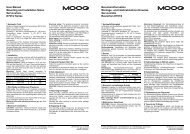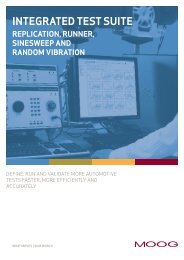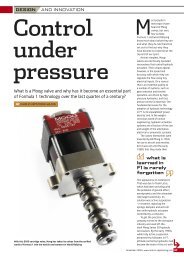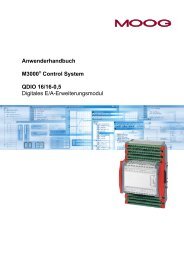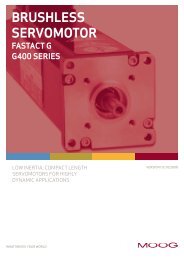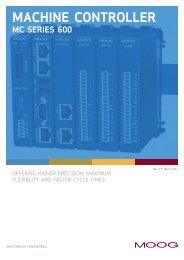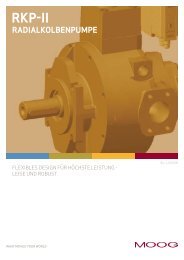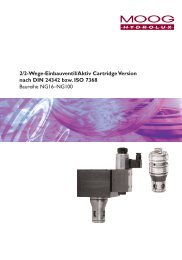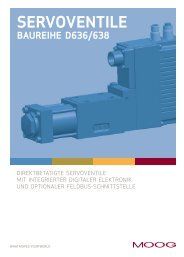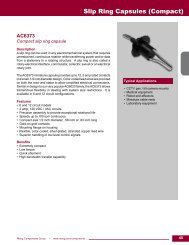User Manual M3000® Automation System / MSC II (Moog Servo ...
User Manual M3000® Automation System / MSC II (Moog Servo ...
User Manual M3000® Automation System / MSC II (Moog Servo ...
Create successful ePaper yourself
Turn your PDF publications into a flip-book with our unique Google optimized e-Paper software.
13 Index<br />
P<br />
Packaging<br />
Original packaging is to be retained! •3<br />
Part number<br />
<strong>MSC</strong> <strong>II</strong> Starter Kit • 114<br />
MSD Motion Controller Starter Kit • 114<br />
Part numbers<br />
CAN bus accessories • 120<br />
CAN bus termination resistors • 120<br />
interface cables • 120<br />
license key of the <strong>MSC</strong> <strong>II</strong> • 118<br />
M3000 ® Starter Kits • 114<br />
<strong>MSC</strong> <strong>II</strong> • 115<br />
MSD Motion Controller • 115<br />
plug-in terminal strips for DIN rail modules • 121<br />
power supply device • 117<br />
Q-modules • 116<br />
R-modules • 117<br />
software<br />
MACS • 119<br />
software for R-modules • 119<br />
software maintenance contract • 119<br />
training programs • 123<br />
Peer-to-peer connection of 2 network stations<br />
(Ethernet) •47<br />
Performance characteristics of the <strong>MSC</strong> <strong>II</strong> •73<br />
interfaces, see interfaces of the <strong>MSC</strong> <strong>II</strong><br />
I/Os, see I/Os of the <strong>MSC</strong> <strong>II</strong><br />
’Outputs Enabled’ output,<br />
see I/Os of the <strong>MSC</strong> <strong>II</strong>: ’Outputs Enabled’ output<br />
watchdog, see watchdog of the <strong>MSC</strong> <strong>II</strong><br />
Personnel, selection and qualification<br />
only qualified users may work with and on M3000 ® ! •2<br />
Pin assignment, see terminal assignment<br />
Place of storage for manuals •1<br />
Plug assignment, see terminal assignment<br />
Plug-in terminal strips for DIN rail modules<br />
connection methods •46<br />
connectors for plug-in terminal strips<br />
front view of the DIN rail module •29<br />
«X2», «X4», «X6», «X7», «X9», «X10» connectors of<br />
the <strong>MSC</strong> <strong>II</strong> •77<br />
part numbers • 121<br />
required number • 122<br />
side view of DIN rail modules with plug-in terminal strips •29<br />
spring loaded terminals •46<br />
Potential equalization in CAN bus networks,<br />
see CAN bus networks: potential equalization<br />
Power consumption by DIN rail modules •40<br />
Power supply • 39–45<br />
characteristics •39<br />
connecting M3000 ® modules •41<br />
digital I/Os of the <strong>MSC</strong> <strong>II</strong> •93<br />
maximum admissible current •43<br />
<strong>MSC</strong> <strong>II</strong> • 75, 89–90<br />
«L1+» (LED for displaying the state of the power supply<br />
for the internal electronics) •81<br />
power supply device<br />
part number • 117<br />
rated voltage •39<br />
safety extra-low voltage SELV •39<br />
sensors • 43–45<br />
switching on/off the power supply<br />
behavior of the <strong>MSC</strong> <strong>II</strong> •89<br />
terminal assignment •78<br />
Processor of the <strong>MSC</strong> <strong>II</strong> •73<br />
Product range • 114–123<br />
Profibus • 50–53<br />
9 pole D-sub connector •52<br />
connector with internal logitudinal inductivity •52<br />
connector with switchable termination •52<br />
maximum cable lengths •53<br />
modules with Profibus DP interface •50<br />
number of network stations •51<br />
permissible stub cable lengths •53<br />
Profibus interface of the <strong>MSC</strong> <strong>II</strong><br />
terminal assignment of the «F-Bus» connector •79<br />
suitable cables •53<br />
topology •51<br />
wiring •50<br />
Profibus DP interface<br />
<strong>MSC</strong> <strong>II</strong> • 100<br />
Programming languages in MACS •25<br />
Programming the <strong>MSC</strong> <strong>II</strong> •84<br />
Project planning •37<br />
safety instructions • 8, 40, 43<br />
Proper operation, see proper use<br />
Proper use •2<br />
safety related systems •2<br />
Protection class of the <strong>MSC</strong> <strong>II</strong> •75<br />
Pulse detection of digital inputs •97<br />
© <strong>Moog</strong> GmbH <strong>User</strong> <strong>Manual</strong> M3000 ® and <strong>MSC</strong> <strong>II</strong> (CA65865-001; Version 1.1, 08/08) 134<br />
Q<br />
QAIO 16/4, see Q-modules: QAIO 16/4<br />
Q-connector<br />
40 pole connector of the E-bus interface •60<br />
front and side views of DIN rail modules •29<br />
front view of the <strong>MSC</strong> <strong>II</strong> •77<br />
QDIO, see Q-modules: QDIO<br />
QEBUS-CAN, see Q-modules: QEBUS-CAN<br />
Q-modules •17<br />
part numbers • 116<br />
power consumption •40<br />
QAIO 16/4 •18<br />
QDIO •18<br />
QEBUS-CAN •19<br />
Qualified users, see personnel, selection and qualification<br />
R<br />
Rated voltage of the power supply •39<br />
RDIO, see R-modules: RDIO<br />
RDISP, see R-modules: RDISP<br />
Rebooting the <strong>MSC</strong> <strong>II</strong>, see resetting the <strong>MSC</strong> <strong>II</strong><br />
Release date of this manual •1<br />
Remote modules, see R-modules<br />
Removing<br />
DIN rail modules from the DIN top-hat rail •36<br />
license key of the <strong>MSC</strong> <strong>II</strong> •87<br />
required tool •86<br />
Repair •70<br />
<strong>Moog</strong> Authentic Repairs •70<br />
repair seal •70<br />
safety instructions •9,69<br />
Reproduction prohibition for this manual •A<br />
Reservation of changes for this manual •A,1<br />
Reset button of the <strong>MSC</strong> <strong>II</strong> • 77, 88<br />
safety instructions • 12, 88<br />
Resetting the <strong>MSC</strong> <strong>II</strong> •88<br />
reset button, see reset button of the <strong>MSC</strong> <strong>II</strong><br />
safety instructions • 12, 89<br />
Restarting the <strong>MSC</strong> <strong>II</strong>, see resetting the <strong>MSC</strong> <strong>II</strong>





